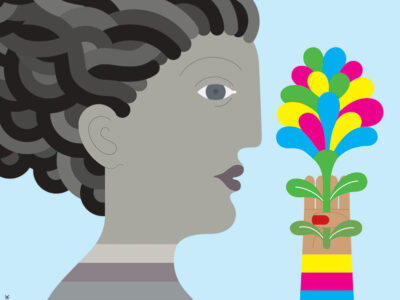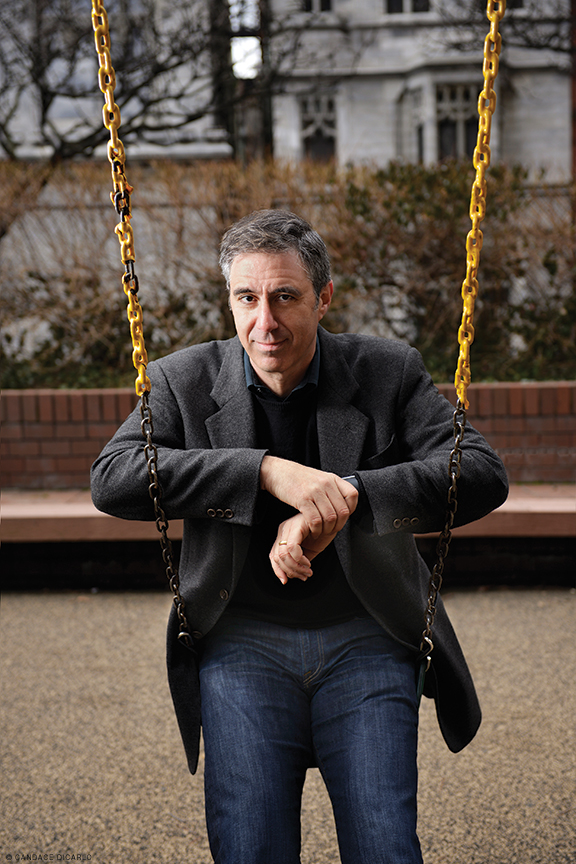
Alumnus, journalist, and self-described math geek Alan Schwarz saw something rotten in the number of kids diagnosed with ADHD and treated with amphetamines. He responded with a powerful series in The New York Times—and an even more powerful book.
BY SAMUEL HUGHES
Photograph by Candace diCarlo
Illustration by Chris Gash
EXCERPT | ADHD NATION: Children, Doctors, Big Pharma, and the Making of an American Epidemic
PLUS | A Brief & Incomplete Timeline of ADHD

When Alan Schwarz C’90 began his investigation into Attention Deficit Hyperactivity Disorder and the explosive growth in its diagnosis and treatment, he saw it as a story about academic pressure.
“It wasn’t about ADHD, and it wasn’t about Adderall, though obviously it needed to discuss both,” he says of his first New York Times article on the subject, which was published in June 2012 and opened with a high-school boy snorting Adderall before taking the SATs. “But during the extensive research for that article, it became extraordinarily clear that the system through which the kids were getting these medications—not just from their friends, but from their friends who had gotten them from doctors—was extremely screwed up.
“High-school kids were not snorting Adderall or feeling like they had to pop Vyvanse to stay up until 2:00 or 3:00 and then be coherent for the exam at 9:30 because they wanted to,” he adds. “They were doing it because the grownups made them feel as if they had to. And the grownups hadn’t taught them—not just how to succeed, but how to fail.”
That series served as the foundation for ADHD Nation: Children, Doctors, Big Pharma, and the Making of an American Epidemic , published last fall by Scribner. The book shines a thoroughly unflattering light on the symbiosis among pharmaceutical companies, psychiatrists, doctors, and researchers. It’s also a crackling good read, not so much a Whodunnit as a Howthehelldidthishappen?
According to Schwarz, the short answer to that question is the steady loosening of diagnostic criteria for the disorder, which he chronicles in deep and damning detail.
“The process through which this diagnosis was being made and the prescriptions written was extraordinarily haphazard,” he says. “To anybody who could A) listen to kids, and B) read scientific studies, it was clear as day that ADHD was being wildly misdiagnosed and prescriptions written unjustifiably.”
Yet when he would “bring those obvious situations to people in charge—psychiatrists or professional organizations, pediatricians or school officials or even drug companies—all the grownups said, ‘No, no, no, that doesn’t happen. That’s just exaggerated,’” he says. “Or, ‘No, it’s not misdiagnosed. You can’t trust those numbers.’ Here we had something that was endangering the brains of children, and the grownups didn’t seem to want to know about it.”
For the record, Schwarz is hardly an anti-med absolutist, and in ADHD Nation he writes that “only the cruelest of critics would deny that many children were benefitting” from both the diagnosis and the medication.
“I’m not saying that ADHD isn’t real, or that the drugs are the devil’s work,” he explains in our interview. “I’m saying that, given their existence and the inevitability of their use, how can we handle that more responsibly?
“I don’t advocate for any particular reform,” he adds. “I try to give people the tools through which to consider it on their own.”
One tool is the not-so-hidden camera of his reporting, through which the reader can observe what was going on behind the scenes for all those years.
A few tidbits:
The school psychologist handed Mrs. Parry a pamphlet called “ADHD—Attention Deficit-Hyperactivity Disorder and Learning Disabilities—Booklet for Parents.” It was written by Larry B. Silver, MD. The passage on medication read: Parents should be aware that these medicines do not “drug” or “alter” the brain of the child. They make the child “normal.” The pamphlet was funded and produced by Ciba-Geigy, the Swiss pharmaceutical firm.
Recognizing Concerta’s blockbuster potential, Johnson & Johnson, the pharmaceutical behemoth, acquired ALZA in May 2001 for $10.5 billion. Its subsequent magazine ads almost flaunted drug companies’ newfound freedom. One had a mother gazing proudly at her smiling son and saying: “Better test scores at school, more chores done at home, an independence I try to encourage, a smile I can always count on.” Every one of those promises was misleading or simply baseless.
One of Shire’s Adderall XR Web pages warned parents that ADHD kids were at “high risk for repeating a grade or dropping out.” Another said that many children with ADHD can also have conduct disorder … Adderall XR had not only never been shown to address those behaviors, the company hadn’t even looked into them. Nonetheless, parents got the message: Give your child Adderall or else he could become a car-crashing, felonious psychopath.
Schwarz hadn’t planned on becoming an investigative journalist. A self-described “math geek” from a family of math geeks, his real dream was to be a high-school math teacher. We’ll get back to that dream later, but for now we’ll just note that at Penn, along with all the sportswriting he did for The Daily Pennsylvanian, he not only majored in math but credits his math professors for teaching him how to write.
“Proofs are narratives,” he says, “and narratives are proofs.” Press him a bit and he’ll describe his craft in terms of “establishing facts, deriving conclusions, merging those conclusions with other facts, getting from A to B to C to D to E to F to G, and making sure you only use facts that [have been] proven.” Skip a step, “and the whole thing falls apart.”
His talent for infusing human interest into math-related subjects was evident in his first book, The Numbers Game: Baseball’s Lifelong Fascination with Statistics (2004, St. Martin’s) [“Arts,” Sep|Oct 2004], which brought some fascinating and forgotten characters to life and was ESPN’s 2004 Baseball Book of the Year. He was still primarily a sportswriter then, having been senior writer for Baseball America from 1991 till 2007, when he joined the Times’ staff after years of freelance contributions. Over the next four years, he wrote more than a hundred articles about sports-related concussions and other brain trauma, as well as the NFL’s cover-up of concussion-related issues in retired players [“Alumni Profiles,” Jul|Aug 2012]. His work in that unexplored field was profiled by outfits ranging from The New Yorker to PBS’s “Frontline,” and its impact went beyond mere awards—though any time you’re a finalist for a Pulitzer Prize (as he was in 2011), you’re in pretty select company. Schwarz’s articles led directly to congressional hearings, major changes in the NFL’s approach to concussion-management, and the league’s begrudging acknowledgement that those head injuries can, in fact, lead to serious long-term problems.
“The NFL has basically lost only one public-relations war in its existence, and that was the issue of the effects of concussions in brain trauma in players,” he says. “I hate to sound so self-congratulatory, but to the extent that I am recognized as the guy who stuffed it down the NFL’s throat, I won because I never deviated off center. I stayed right down the middle. They never had anything where they could say ‘That’s unreasonable, that’s wrong.’”
By 2011, having “gone through the wringer” with the concussion stories (which prompted some death threats, he says), Schwarz was ready to move on from sports and into in an area that he already cared deeply about: education.
“I had heard that some kids in high schools like the one I went to in Scarsdale, New York, were under so much academic pressure to perform that they were abusing and even snorting Adderall,” he says. “Now, I knew that this was possible because there was a Family Ties episode on it in 1983. But it resonated with me more as an adult.”
The 2013 Statistical Reporting Award, a kind of lifetime achievement award from the American Statistical Association, is not something most journalists dream of winning, but it must have given great satisfaction to Schwarz. His examination (with a Times colleague) of raw data from the Centers for Disease Control is just one example; it showed that the number of children diagnosed with ADHD was not 11 percent, as the CDC had concluded, but “15 percent of all American children today.” (Among boys it’s 20 percent.) That’s three times the number of kids that the American Psychiatric Association’s own population-assessment indicated should have the disorder.
“All I ask is that, ‘Hey, doctors, follow the rules that you set up for yourselves,’” he says. “You’ve told us what ADHD is. You lay out how to diagnose it properly—what it is, what it isn’t. You told us that population studies suggest that ADHD occurs in about 5 percent of children. Fine, I’ll accept that, and I’ll even do it in good faith. Now, if you would like to argue arithmetic with me and say that 15 is not 5 x 3, and that the difference between 15 percent of 56 million children and 5 percent of 56 million children is not millions of children—bring it on, because I’ll bury you.
“I can’t wait for somebody at the APA to say, ‘Well, you know, that 5 percent number is a little squishy,’ or ‘It really should have been something else,’” he adds. “At which point I would reply, ‘Well, what else in the definition was half-assed? What else did you mess up?’ I mean, they’re screwed no matter what they do.”
“Part of the strength and accomplishment of ADHD Nation,” notes Christopher Lane in Psychology Today,is that it clearly shows how impossible it is to separate the “elasticity or diagnostic imprecision” from the “pharma-sponsored hype, the funded patient groups, the selectively reported trials, and the KOLs [Key Opinion Leaders] who find personal checks left on their desks (‘for further studies’) and scripts handed them [to read] if they’ll outright deny the medication’s side effects.”
Schwarz’s indefatigable reporting—more than a thousand interviews as well as serious archival digging—led to a trove of historical and scientific detail, which he sprinkles throughout. (What’s now called ADHD was once called Minimal Brain Disorder, for example, while Adderall is a contraction of ADD for all, which is a bit more appealing to parents than its previous name: Obetrol, a contraction of Obesity-control.)
To put a human face on the numbers and history, Schwarz weaves the stories of real, emblematic characters into the fabric of his narrative. One is Keith Conners, the retired professor of psychiatry and behavioral sciences at Duke (among other places), whose early diagnostic scales laid the groundwork for assessing and treating ADHD. Now 83, he was a key force in the surge of diagnoses and treatment with stimulants. As Schwarz notes inADHD Nation, he foundedthe Journal of Attention Disorders in 1996, which “allowed dozens of ADHD studies per year—many of them funded by Big Pharma, naturally—to be published and entered into the forever citable scientific literature.” But in recent years Conners came to believe that the system he helped create had become a “national disaster of dangerous proportions.”
The other two human storylines in Schwarz’s narrative are of students. One is Jamison Monroe, a fast-track kid from Houston who struggled with the workload at his new private school, prompting him to fake the symptoms of ADHD for his easily duped psychiatrist. (“Only an idiot couldn’t fake something called ‘attention deficit disorder,’ he told himself. Stare out the window. Act distracted, say ‘what?’ a few times. Say your schoolwork is slipping—that’ll clinch it. ”) He got a prescription for Adderall in 1995, just after it became the first amphetamine to be approved by the FDA. (Ritalin, the brand name of methylphenidate, is a “slightly tweaked formulation” of Dexedrine, an amphetamine notoriously overprescribed in the 1960s and ’70s.) After taking ever-larger doses, Jamison spiraled out of control and ended up in a drug-rehab center that—incredibly—let him keep taking his daily Adderall, because his doctor said he had ADHD. (“‘A way to get high in rehab!’ Jamison said to himself.”) Unsurprisingly, that stint didn’t help, and he ended up at another rehab center, where he finally faced his amphetamine addiction head-on. He came to a serious conclusion: he needed to open his own treatment center “for teenagers like I was when this all started.” Thus was born Newport Academy, which now has three locations around the country, “dedicated to helping teenagers recover from substance-use disorders and other psychiatric troubles.”
The other student—Kristin Parber (a pseudonym), from the Philadelphia suburbs—became one of Newport’s first patients. Her ADHD diagnosis at age 8—prompted by over-ambitious parents and aided by a November 30, 1998 Time magazine cover story easing parents’ concerns about Ritalin—led to a prescription that ratcheted up her anxiety levels. (Her psychiatrist responded not by cutting off the Ritalin but by prescribing Xanax for anxiety and Lexapro for depression.) Eventually she was abusing enough Ritalin (and cocaine) to get herself pulled out of school, and hence to Newport Academy, where she is now a co-director.
Needless to say, each child is unique, and the way Jamison and Kristin responded is by no means a predictor for others. But their stories were both very real and relevant for Schwarz’s larger story.
“I realized that Jamison and Kristin could or did fit the theme that I was trying to portray—without any massaging of facts,” he says. “Part of me was reluctant to follow them because it’s kind of old—you know, mid-’90s, 2000s. But you can’t profile a kid going through it right now. So when I realized, ‘Wait a minute, those could be the three strands I could braid,’ I started to see how the book could be structured and the material could be delivered in a narrative form.”
The narrative takes on a meta quality when Keith Conners reads a front-page article in the February 2, 2013 Times titled “Drowned in a Stream of Prescriptions.” That article chronicled the tragic fate of a young man named Richard Fee (see excerpt on p. 44), who committed suicide after becoming addicted to Adderall through a series of distressingly casual diagnoses of ADHD.
Having written that Times article—in which the elderly psychiatrist acknowledges that scales like the one he created “have reinforced this tendency for quick and dirty practice”—Schwarz wrestled with how to present Conners’ reaction in the book. Journalistic modesty advised him to keep himself out of his narrative, but it didn’t make sense not to mention the article, since Conners had assured him that it was the key factor in his decision to take a stand against the pharmacological tidal wave he had helped unleash.
“As Conners kept reading the sprawling, operatic tragedy, each paragraph more horrifying than the one before, it shook his soul unlike any other reader’s,” Schwarz writes in ADHD Nation. “He felt almost ashamed. He felt … complicit … Did I help pharma cover up the dangers of these drugs? … Conners didn’t feel as if he had killed Richard Fee. But the system he had helped build sure did.”
Despite the warts-and-all portrait, or perhaps because of it, Conners was deeply impressed. In an email, he told Schwarz that ADHD Nation was a “masterpiece of investigation, storytelling, and documented history,” and that he was proud to have contributed to “one of the most important medical stories of our generation that needed to be told.” The book, he added, “is one I wish I had written.”
Though ADHD Nation has received very good reviews (Kirkus Reviews called it “powerful” and “necessary”; New Republic hailed it as a “dazzling piece of journalism”), the reaction in the communities most affected was “dishearteningly predictable from both sides,” says Schwarz. “Some people who decry child psychiatry as a construct say: ‘See! I told you ADHD was a pharma-constructed conspiracy to mind-control children!’—which the book doesn’t come anywhere near arguing. Those on the other side, who think everything in the ADHD world is perfectly hunky-dory, say: ‘Schwarz is just a muckraking alarmist trying to sell books. He’s not even a doctor! What could he possibly know?’ The ADHD factions have grown so polarized and unwilling to learn anything that they use the book as a sword, not a mirror.
“Intractability is an indulgence,” he adds. And those who refuse to listen to the other side “need to go back and look at who you were actually serving—your own belief in right and wrong, or if you were actually trying to help kids.”
What frustrates Schwarz is the dearth of studies that could assess the repercussions of misdiagnosis. “What is the cost when we get it wrong? What is the cost of telling a kid there’s something wrong with your brain when in fact there is not?” And because researchers can’t, for ethical reasons, carry out scientific studies on the effects of misdiagnosis— Group B is going to be 100 eight-year-olds who were put on Adderall without justification, and told they have ADHD when we know they don’t —there will “never be formal evidence of the cost or long-term effects,” he notes. As a result, psychiatrists and researchers and pediatricians “don’t understand what I’m talking about because they haven’t read it in [the Journal of Child and Adolescent Psychopharmacology]. It defies all common sense—and what’s staring us right in the face.”
As for the companies that produce the stimulants in question, he says: “I’m confident it will have no effect on Big Pharma’s behavior—its playbook of paying off researchers and exploiting advertising has proven too effective, and too condoned by lawmakers, to be adjusted by something as quaint as a book. I’m only slightly more hopeful that the American Medical Association and the American Academy of Pediatrics might learn something about what they have allowed to develop, and step up efforts to make sure practitioners who diagnose ADHD know more about what the disorder is and isn’t, and what the medications are and are not. My guess is that the only way such organizations will [respond] is through Congressional hearings—after some Senator’s child dies.”
He does hope that some parents and educators will “learn how to approach a typical situation—a child is struggling in school, and is suspected of perhaps having ADHD—with far more information than before,” and that they will “consider all possible explanations and treatments for the behavior, rather than jumping to a diagnosis and medication in 20 minutes.
“Even small, incremental reforms can make a huge difference,” he adds. “If current diagnoses decrease from 11 percent to merely 10—which is still nowhere near appropriate—that’s half a million children not being misdiagnosed with a lifelong brain disorder. And it’s so easy if people just wake the hell up.”
At the ripening age of 48, Schwarz has had a journalistic career that many would envy. But the dreams of a math geek don’t fade in the daylight.
“I always treated journalism as teaching—just teaching at a different blackboard,” he says. Though that “detour into journalism” lasted 25 years, he finally left the Times last August, and has been back on the Highway of Proof since then, with the help of the paper’s buyout.
“I’m teaching Algebra 2 and geometry at the Dalton School, an elite private school in Manhattan,” he says. He’s doing it as an unpaid volunteer, which means that he doesn’t have to deal with parents or school politics, or even grade papers. “So it’s clearly not the true experience,” he admits. But still: “I’m in heaven—so much so that I now come in all day Monday to Friday.”
Journalism, after all, “deals primarily with the irreconcilable—politics, poverty, and, for me, football safety and child psychiatry,” he says. “The arguments never end. There are no right answers; at best, there are only those less wrong. But math? There’s one right answer. You either get it or you don’t. No specious agendas. No disingenuousness. Its incontrovertibility is very attractive.”
He hasn’t given up on writing altogether, though.
“I do expect to write more books—but books on math, and relatively lighthearted ones,” he says. “I might also do something on mathematics in journalism, using my experiences—if I can figure out how to avoid the inherent narcissism.
“Let’s face it—I’ve always said that writing was mathematical, so it’s hard to deny that math mimics writing,” he concludes. “They’re my double helix.”
EXCERPT
“You keep giving adderall to my son, you’re going to kill him!”
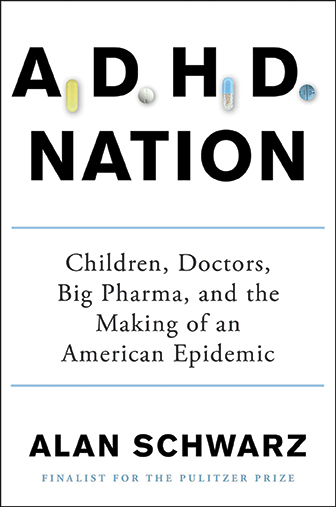
In August 2009, Richard Fee walked into the office of the Triad Psychiatric & Counseling Center in Greensboro, North Carolina, the just-down-the-street clinic for students at Greensboro College who wanted prescriptions for Adderall. At the time Richard had everything going for him—academic scholarship, first baseman on the college baseball team, handsome and charismatic enough to have been elected president of his sophomore class. He wanted to go to medical school. Having bummed Adderall pills off friends for a while, he decided to get his own supply by faking ADHD to a gullible Triad nurse. She wrote down his complaints: “poor organization, memory, attention to detail.” She gave him an airy eighteen-question survey—not the official Conners Scale, but a descendant of it—and totaled up the zero-to-three scores. Twenty-nine? Yep, ADHD. She arranged for a prescription. The drug worked so well that, a few weeks later, Richard returned to ask that the dose be increased to 50 milligrams. She complied. He soon asked for 60. She green-lighted three months’ worth of medication in forty-three days.
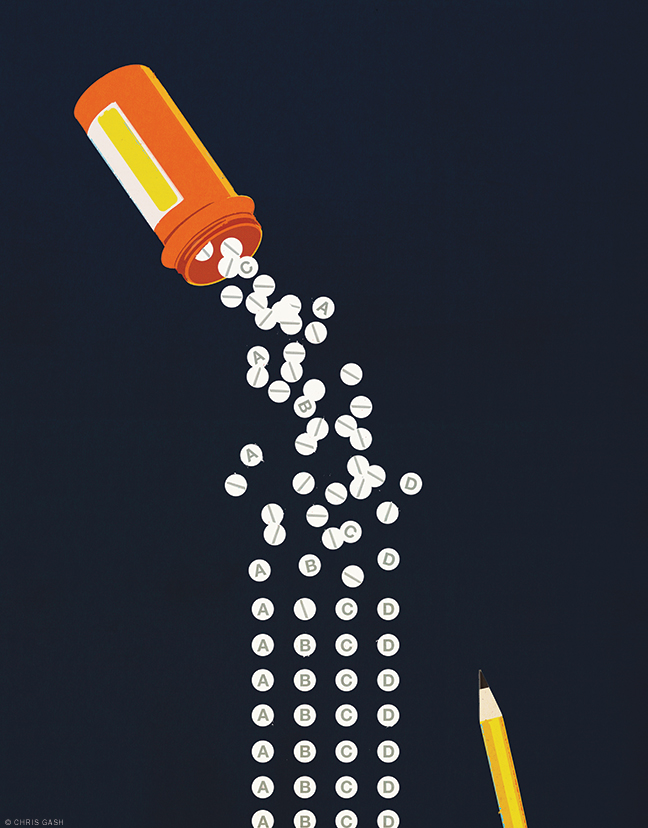
When Richard graduated and moved back home to Virginia Beach, Virginia, to study for medical school entrance exams, he visited a local psychiatrist to get his Adderall prescriptions refilled. Dr. Waldo Ellison listened to the young man’s complaints, assumed that his original ADHD diagnosis back in Greensboro had been correct, and began writing Richard regular scripts. Because they met only for five-minute “med checks” once a month the doctor did not notice that Richard was abusing the pills from the start. He would blow through his monthly supply in a few weeks, staying up all night reading and scribbling in notebooks. As amphetamine psychosis took hold, he would climb out his bedroom window onto the roof to talk with the moon and stars. Another side effect of amphetamine abuse is elevated body temperature; Richard would get so overheated that he walked around the house with ice packs around his neck—and, in frigid weather, cooled off by jumping into his parents’ fifty-two-degree backyard pool. Richard’s father, Rick, confronted him about his bizarre behavior and whether it had anything to do with Adderall; his son replied, “The doctor wouldn’t give me anything that’s bad for me, Dad—I’m not buying it on the street corner.” When Rick watched Richard grow increasingly violent and heard him complain that his computer camera was spying on him, Rick went to Dr. Ellison’s office to discuss the prescriptions. The doctor refused to talk about Richard, citing patient privacy laws. Rick got so frustrated that he yelled at Dr. Ellison, “You keep giving Adderall to my son, you’re going to kill him!” Dr. Ellison did leave Mr. Fee with some reassurance, though: This doctor had tremendous experience in this area, he explained, because, “I prescribe more Adderall than anyone in the state.”
When Richard’s parents convinced him to see a different psychiatrist, Dr. Charles Parker, they specifically instructed the new doctor not to prescribe Adderall; the doctor understood this so well that he wrote in his chart “no meds” with a box around it, as well as noting Richard’s anxiety and suicidal thoughts. And yet, not long afterward, Dr. Parker gave Richard a prescription for Adderall, and eventually a huge dose of 80 milligrams a day. The doctor later recalled that Richard had seemed so sincere about his needing the drug for ADHD—an aspiring medical-school student wouldn’t lie about something like this, would he?—and didn’t exhibit any outward signs of abuse during their occasional appointments. Richard’s delusions returned so severely that he spent a week in a psychiatric hospital. When he got out, and needing his amphetamine fix, Richard returned to Dr. Ellison. After only six minutes in the office, Richard left with not one, but three thirty-day prescriptions for Adderall: one for that day, and one each for the next two months, so that he didn’t have to schlep to the office for more. When Richard’s father returned to Dr. Ellison to ask what in God’s name he was thinking, it was too late— Richard had his three-month supply. By the time those pills ran out, Richard became so violent that his rages forced calls to the police. He moved into his own apartment and became despondent, withdrawn, and suicidal anew. He didn’t recover. His life and psyche in tatters, he hanged himself in a closet. The Fees held a gathering in Richard’s memory afterward. His old college friends recalled how they, too, had used Adderall in college—to cram, just like Richard did—and realized Richard’s fate could have easily been theirs. A baseball teammate later recalled: “It’s so prevalent and widely used, people had no idea it could be abused to the point of no return.” Still grieving as the anniversary of Richard’s death approached, Mr. and Mrs. Fee noticed in the local paper that a new documentary called “ADD and Loving It?!” was being screened at a nearby auditorium, followed by a panel discussion among experts. They decided to go. It was being hosted by CHADD, whose emcee opened by thanking their sponsor for the event: Shire pharmaceuticals. The hour-long movie was of the Ned Hallowell genre, casting ADHD as a humorous, and often positive, condition; afflicted spouses giggled about misplaced keys and forgotten appointments, while doctors recalled the “enthusiasm and excitement” their patients had felt upon diagnosis. It closed by examining several “myths” about stimulant medications, with doctors praising their efficacy and safety, mentioning no risks. Hallowell himself said the pills were “safer than aspirin,” while another clinician was even more reassuring. “It’s okay,” he said. “There’s nothing that’s going to happen.” Rick Fee seethed silently. After the movie ended, during the expert panel Q&A, he rose from his fourth-row seat to ask a question. The panel was moderated by a local clinical psychologist named Jeffrey Katz, who also happened to be chairman of CHADD’s public policy committee. “What are some of the drawbacks or some of the dangers of a misdiagnosis in somebody,” Rick Fee asked, “and then the subsequent medication that goes along with that?” Dr. Katz took the question. “Not much—the medication itself is pretty innocuous,” he replied. He explained that people without ADHD would see no benefit from Adderall and stop on their own. Dr. Katz concluded, as if puzzled by the question: “If you misdiagnose it, and you give somebody medication, it’s not going to do anything for them. Why would they continue to take it?”
Reaction to the Times’s profile of Richard Fee was as polarized as ever, with critics of the ADHD explosion being generally drowned out by those most invested in the disorder’s continued popularity. CHADD’s president blogged that Richard’s death was clearly tragic, but “stimulant medications that are taken as prescribed are highly unlikely to lead to addiction”—avoiding the issue at hand, which was the not uncommon circumstance when they are prescribed, and taken, improperly. An official from the Child Mind Institute, a New York clinic devoted to diagnosing and treating children with ADHD—and whose president, Dr. Harold Koplewicz, had been involved with NYU’s “Your Kid Will Pay” ransom-ad marketing campaign—took the standard route of claiming that the Richard Fee story only “verges on the kind of fear-mongering that is unhelpful to parents trying to provide the best support and care to struggling children.” The most befuddling response came in a Times Letter to the Editor from Martin J. Drell, the president of the American Academy of Child and Adolescent Psychiatry, whose journal had long survived on glowing reviews of ADHD medications and pharmaceutical advertising. Dr. Drell emphasized that the millions of Americans with ADHD were at risk for “accidents, injury and substance abuse,” but that “fortunately, effective treatment is available.” One doctor, though, read the story of Richard Fee and had a reaction all his own. The events didn’t take place in his office, and he had never met or spoken with the patient or doctors involved. He didn’t write the prescriptions—and, in fact, still deeply believed in the benefits of ADHD medication. But as he put down the newspaper, having soaked the ghastly story in, he felt a unique sensation. He didn’t feel particularly sad. He wasn’t angry either. No. It was something different, more personal. He felt embarrassed. That Sunday morning, Dr. C. Keith Conners decided that ADHD, whose Manhattan Project he had so enthusiastically helped lead, had clearly melted down. Not just on college campuses, but everywhere. His questionnaire, for which he was now annually getting $600,000 in royalties, and others were making false diagnoses for lazy doctors nationwide. The medications he had championed were being as overprescribed as antibiotics. As he recalled all his work for pharmaceutical companies—from CIBA to Abbott to Shire to ALZA to Lilly and more—he feared that his career had strayed from medicine to marketing. After disregarding four decades of gathering clouds, Conners decided to get up and see just how bad the situation had become. He quickly found it worse than he even feared. Drug companies had grown unsatisfied with the population of children that he himself had discovered. Those kids were now growing into adults—and as they did, Big Pharma wanted to keep their business.
Excerpted from ADHD NATION: Children, Doctors, Big Pharma, and the Making of an American Epidemic. Copyright © 2016 by Alan Schwarz. Excerpted with permission by Scribner, a Division of Simon & Schuster, Inc.
A Brief & Incomplete Timeline of ADHD
(All quoted passages are by Schwarz unless otherwise indicated.)
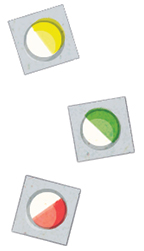
1937
Charles Bradley publishes a study of the effects of Benzedrine on 30 schoolchildren with significant behavioral issues in the American Journal of Psychiatry. The children “immediately showed more interest in school … Their comprehension, speed, and accuracy improved, too … Moreover, the pills calmed the otherwise uncalmable.” But there were “several cases of nausea, insomnia, and heightened anxiety”; the “benefits lasted only as long as the pills did”; and the children’s “underlying physical and mental problems still needed careful psychosocial therapy from trained professionals.”
Later that year, Time magazine reports that “students at several Midwestern universities are taking the ‘new, powerful but poisonous brain stimulant’ to stay up nights on end to study.” Two years later, when a Purdue student died soon after taking the pills, “the tragedy was reported widely enough that Benzedrine’s dangers became too conspicuous for Smith, Kline & French to sell it as a tool to control children’s mental states”—which did not yet have a name. (Soon it would: first “minimal brain damage,” then “minimal brain dysfunction,” then “minimal brain disorder.”)
1956
Ritalin (methylphenidate, named for Rita Panizzon, the tennis-playing wife of the CIBA chemist who formulated it in the mid-1940s) is released in the US for adults.
1962
Leon Eisenberg and Keith Conners conduct a study, funded by the NIMH, in which Ritalin is given to 39 “disturbed children” and a placebo to 39 more. Most of the Ritalin kids improved dramatically, becoming less impulsive and more alert. But many “lost their appetites, others struggled to sleep, and a few became more anxious than usual.”
1969
Keith Conners presents his 39-question Teacher Rating Scale, which would “quite precisely measure a kid’s behavioral symptoms before and after a trial of Dexedrine or Ritalin,” in the American Journal of Psychiatry.
1970
The Washington Post reports that 5 to 10 percent of children in the Omaha elementary-school system, mostly black, are taking Ritalin, Dexedrine, or other drugs to control their hyperactivity and other disruptive antics, all part of a ‘behavior modification program.’” That year the Controlled Substances Act places “unprecedented restrictions on the handling of addictive pharmaceuticals like Dexedrine and Ritalin … US production of amphetamines plummeted an astonishing 90 percent in only a few years.”
1971-80
Child psychiatrist Virginia Douglas defines the disorder as one of insufficient attention. In the 1980 Diagnostic Manual of Mental Disorders (DSM) the term is called Attention Deficit Disorder. Conners’ 39-item checklist of symptoms has been cut to 16, with some overlapping. (As Schwarz notes: “Any child ‘easily distracted’ would have ‘difficulty concentrating,’ too.”) The DSMstates that in the US, ADD “may occur in as many as 3 percent of prepubertal children.” An NIMH researcher warns: “ADD could replace oedipal anxiety as a new universal explanation; I urge restraint.”
1987
In the revised DSM, the APA renames ADD Attention Deficit Hyperactivity Disorder (ADHD); later, a sub-diagnosis called “attention deficit hyperactivity disorder without hyperactivity” will be added. (Today, says Schwarz, “most people skip the hassle, just say ‘ADD,’ and leave it at that.”) A group of parents in Florida forms CHADD, a support group of parents with ADD children, which soon persuades Congress to classify ADHD as a learning disability.
1994
Edward Hallowell and John Ratey publish Driven to Distraction, which argues that ADHD, when treated properly, is not only “powerfully positive” but probably what made people like Mozart, Albert Einstein, George Bernard Shaw, and Salvador Dali so special.
On July 18, Time magazine’s cover story on ADHD proclaims: “It’s not just kids who suffer from it,” helping to open up the market for adult ADHD.
1995
PBS broadcasts “ADD: A Dubious Diagnosis?” which reveals that Ciba-Geigy had quietly given CHADD “close to $1 million since 1989 to attract parents and fuel its growth.”
1999
NIMH researchers—the “vast majority” of whom “owed at least some of their professional or financial well-being to pharmaceutical companies”—conduct the Multimodal Treatment of Children with ADHD (MTA) study. The most effective treatment is medication plus therapy (68 percent), followed by medication alone (Ritalin or Concerta, 56 percent) and therapy alone (34 percent). “Neither” came in at 25 percent. The NIMH’s head researcher declares medication the “hands-down winner” compared to behavioral therapy. “Study Says Drugs Best Help for Attention Deficit,” reports ABC World News Tonight, while Clinical Psychiatry News proclaims “Psychosocial Interventions of No Benefit.”
Though the NIMH sound bites did hold some truth, writes Schwarz, they were “delivered with such tone deafness [and] disregard for how the statements would be interpreted by lay audiences, that they became misleading and occasionally downright wrong. Medication did not win ‘hands down.’ Therapy provided far more than ‘no benefit.’
“First, almost half of the kids did not significantly benefit from just medication, a remarkable finding for a study that was trumpeting the benefits of Ritalin,” he adds. “Second, kids in the ‘neither’ group were not getting nothing—they were getting whatever treatments their own doctors were already providing, which was usually Ritalin. Therefore, Ritalin, as used in the real world, was doing a pretty rotten job three-quarters of the time … Behavioral therapy’s success rate was close enough to Ritalin’s that it should still have been presented as viable for families who preferred at least to attempt non-medication approaches first.”
In the end, “the MTA wrote the ultimate prescription for prescriptions,” he concludes. “Schools, already under severe financial pressure, could justify cutting aides and other staff who had been brought in to help ADHD kids; after all, the study showed that one-on-one attention didn’t work better than a pill.”—S.H.



